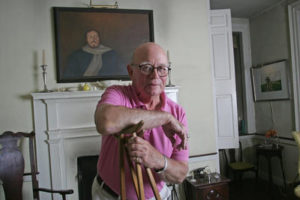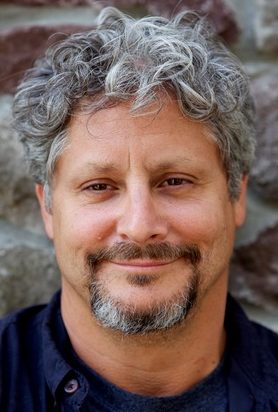By Victor Greto
Frolic Weymouth wasn’t sure what to make of Luciano Pavarotti even before he met him for the first time out at the painter’s Brandywine River estate at Chadds Ford, Pa.
The great tenor, who died from pancreatic cancer yesterday morning at 71 in his home in Modena, Italy, instigated the meeting by asking to have lunch.

“I knew very little about opera,” Weymouth says of the trade of the man who transcended the world of Italian opera through the force of his personality and the depth of his talent.
Even before Pavarotti came to lunch at his home more than 25 years ago, Weymouth received a call from one of the opera singer’s team asking him to have soup, steak and potatoes prepared.
“He also wanted an ice cream sundae with fudge for dessert,” says Weymouth.
“I actually was starting to get a little mad about it all.”
Pavarotti arrived with an entourage, “and within 10 minutes he absolutely charmed me. He wanted me to do a painting of him. I said, ‘Yes,’ right away. He was fascinating.”
For the next year, Weymouth traveled intermittently with Pavarotti, attending concerts, opera performances, and was with him on the set of his one movie, “Yes, Giorgio,” which was released in 1982.
“I was struggling to do it,” Weymouth says of the portrait, explaining the extensive amount of time and traveling — from Florida to Boston to California — he needed to do to capture Pavarotti’s personality.
Pavarotti sat for Weymouth about 30 times.
Weymouth still has drawings he sketched of Pavarotti on stage waving his famous broad, white handkerchief and beaming toward the sound of the applause. Weymouth thought of painting him that way.
But that wasn’t the man Weymouth saw after all those months.
Weymouth’s 1982 painting of the man, his grim visage off-center, wearing a light scarf and black suit, sporting a determined gaze, seems to dare the viewer to understand him.
“He had a wonderful serious side that was very much him,” Weymouth says. “The poignancy of his life, the loneliness he had in those years.”
He missed his three daughters in Italy, Weymouth says.
Born in Modena, Italy, Pavarotti grew up poor, the son of a baker and a cigar factory worker. He toyed with trying to become a professional soccer player and elementary school teacher, before finally making it as a singer.
But when he made it as an opera singer, no one could touch him, says Leland Kimball, general and artistic director of Opera Delaware.
“I remember hearing him in concert very early on at a huge recital at the Kennedy Center in 1972,” Kimball says. “I sat in the last row, and he started singing, and his voice felt like a rocket coming out of his mouth and shooting and stabbing me in the stomach. I almost laughed because he had such a physical effect on me.”
Kimball, who performed on stage with Pavarotti twice, recalls a contentious rehearsal with him while working on La Boheme in Philadelphia in 1982.
A scene where Kimball tipped his hat to Pavarotti and his lover became mangled because Pavarotti always missed his spot. In fact, he was on the other side of the stage.
He screamed at Kimball, calling him by his nickname, Buzz.
“I started babbling,” Kimball says, trying to explain what was wrong.
But Kimball was simultaneously thrilled that Pavarotti even knew his name.
“I can count on the fingers of one hand the number of classical performers who have embraced the whole world,” Kimball says, referring to the tenor’s reach outside the opera world. “One of them was Caruso, at the beginning of the century.”
Comparisons to Enrico Caruso, the great Italian tenor who became a star at the turn of the 20th century, came thick and fast yesterday after word of Pavarotti’s death spread.
Lucinda Williams, executive director of Delaware Symphony, called Pavarotti, “The Caruso of our times. I appreciate the fact that he could bridge the classical musical world to a much larger audience.”
Anne Sullivan, an instructor on the Harp at the University of Delaware, accompanied Pavarotti three times in her career.
She said the man’s charisma helped him transcend the opera world.
“In addition to begin an experience to listen to, he was a showman,” she says. “He brought his personality to the music, and that was an irresistible combination.”
That combination, of course, included some of the greatest music ever written and performed, including Pavarotti’s signature piece, Puccini’s aria, “Nessun Dorma,” from Turandot.
Sullivan accompanied Pavarotti once with the Delaware Symphony, and twice in a makeshift ensemble in Philadelphia, when he appeared at the Spectrum.
“As soon as he walked on stage, you knew that it was different, you could feel the excitement in the audience come back at you. to feel that many people enjoying an experience so intensely,” she says.
Yet, like Kimball, she also got into a bit of trouble with him.
He told her he didn’t like the way she was playing a piece.
“I was a bit flustered,” she says. “I wanted things to be right, and I thought I was playing what would have been fine for anyone else. But it wasn’t for him.”
Although she never understood what was wrong, she played it differently, and he was happy.
“He was insistent, which he had the right to be,” she says.
After all, the people showing up at the Spectrum were there to hear him sing.
“There was the voice, that, especially in his prime, it absolutely compelled you to listen to it,” Sullivan says. “It commanded your attention. You had to listen.”
Carin Brastow, development director at Opera Delaware, for four years was a production manager for the Pavarotti International Voice Competition for young singers in Philadelphia. The winners performed with him.
Pregnant with her son Ian at the time, Brastow said Pavarotti would call her Mama and rub her belly.
But unlike many who say that the tenor could be short-tempered, she saw nothing but kindness and patience.
“Everyone has short tempers at times,” she says. “Considering who he was and what he represented at the opera, he chose to use his recognition to welcome people and introduce them to opera, to break the stigma that only high society can appreciate it.”
Pavarotti was famously booed off the stage during a performance of La Scala in 1992.
“His voice cracked,” Weymouth recalls, “and I thought the booing was bad, but he told me he deserved it. He wasn’t precious at all.”
When Weymouth finished his portrait, he kept it, because, Weymouth says, Pavarotti had no place for it.
The painting now hangs above the fireplace in Weymouth’s sitting room, still challenging anyone who views it to figure out who the man was.
